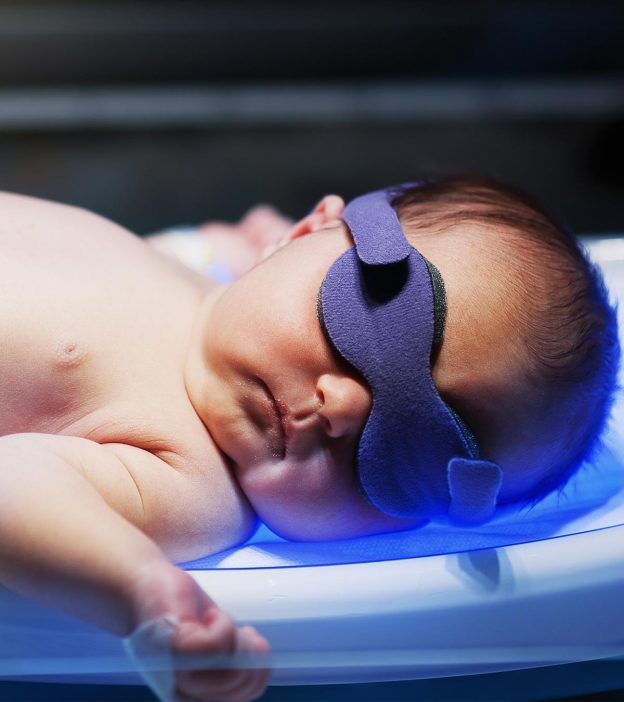What to do if your baby has Neonatal Jaundice

WHAT IS NEONATAL JAUNDICE?
Neonatal jaundice is a yellowish discoloration of the white part of the eyes and skin in a newborn baby, due to high levels of a substance called bilirubin. Bilirubin is a yellow substance in the blood and is supposed to be excreted.
WHAT CAUSES NEONATAL JAUNDICE?
Neonatal jaundice is caused by the buildup of bilirubin in the baby’s blood. Normally, there are small amounts of bilirubin in the body(it is present for a little while, before it is removed by the liver).
During pregnancy, the mother’s liver removes bilirubin for the baby, but after birth the baby’s liver must remove the bilirubin. In some babies, the liver might not be developed enough to efficiently get rid of bilirubin. When too much bilirubin builds up in a new baby’s body, the skin and whites of the eyes might look yellow. This yellow coloring is called jaundice.
HOW COMMON IS NEWBORN JAUNDICE?
Jaundice is one of the most common conditions that can affect newborn babies.
It is estimated that 6 out of every 10 babies develop jaundice, that is, 60% of all babies.
There are more than 100,000 cases per year in Nigeria.
WHAT MAKES A BABY LIKELY TO HAVE JAUNDICE?
Some babies are more likely to have severe jaundice and higher bilirubin levels than others. According to the CDC, some of the factors that make some more likely to have jaundice are:
- Preterm babies:
Babies born before 37 weeks, or 8.5 months, of pregnancy might have jaundice because their liver is not fully developed and may not be able to get rid of so much bilirubin.
- East Asian or Mediterranean Descent:
A baby born to an East Asian or Mediterranean family is at a higher risk of becoming jaundiced. Also, some families inherit conditions (such as G6PD deficiency), and their babies are more likely to get jaundice.
- Feeding Difficulties:
A baby who is not eating, wetting, or stooling well in the first few days of life is more likely to get jaundice.
- Sibling with Jaundice
A baby with a sister or brother that had jaundice is more likely to have jaundice.
- Bruising
A baby with bruises at birth is more likely to get jaundice. A bruise forms when blood leaks out of a blood vessel and causes the skin to look black and blue. The healing of large bruises can cause high levels of bilirubin and your baby might get jaundice.
- Blood Type
Women with an O blood type or Rh negative blood factor might have babies with higher bilirubin levels. A mother with Rh incompatibility should be given Rhogam.
SIGNS AND SYMPTOMS
Jaundice usually appears first on the face and then moves to the chest, belly, arms, and legs as bilirubin levels get higher. The whites of the eyes can also look yellow. Jaundice can be harder to see in babies with darker skin color. The baby’s doctor or nurse can test how much bilirubin is in the baby’s blood.
The symptoms of jaundice include:
- The baby turns very yellow or orange (skin color starts to change from the head and spread to the toes).
- The baby is hard to wake up or will not sleep at all.
- The baby is not breastfeeding or sucking from a bottle well.
- The baby is very fussy.
- The baby does not have enough wet or dirty diapers.
The condition of the baby may worsen if jaundice is not treated on time, and permanent damage to the brain may occur. Some symptoms of worsening are listed below. Get immediate medical help if you notice any of these:
- The baby cries inconsolably or with a high pitch.
- The baby is bent like a bow (the head or neck and heels are bent backward and the body forward).
- The baby has a stiff, limp, or floppy body.
- The baby has strange eye movements.
TREATMENT
If you think your baby has jaundice you should call and visit your baby’s doctor right away. You can speak with a doctor. Ask your baby’s doctor or nurse about a jaundice bilirubin test. Don’t wait! No baby should develop brain damage from untreated jaundice.
When being treated for high bilirubin levels, the baby will be:
1. Undressed and put under special lights. The lights will not hurt the baby.
2. The baby’s milk intake may also need to be increased.
3. In some cases, if the baby has very high bilirubin levels, the doctor will do a blood exchange transfusion.
Putting the baby in sunlight is not a safe way of treating jaundice. Many babies have suffered permanent brain damage or died because of this practice. Take your baby to the hospital for proper medical care. Having health insurance helps you cover the cost for antenatal, delivery and after birth medical bills for baby related illnesses. Get covered on flexicare health insurance for you and your family.

